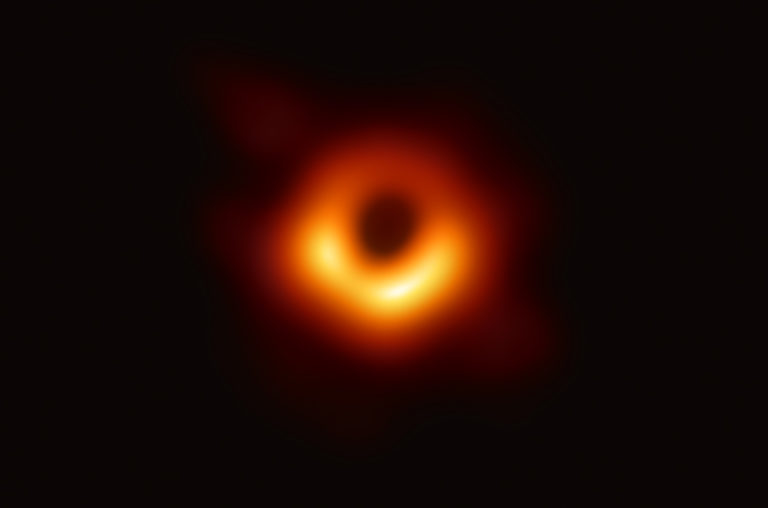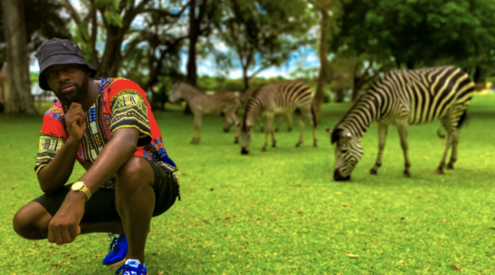For ages, black holes have been mere works of fictions until just yesterday, Wednesday 10 April, when scientists released the first images of one – a supermassive black hole.
The black hole was found right at the centre of the Messier 87 galaxy (or M87), one of the largest galaxies in the universe, over 53-million lightyears away from earth.
The M87 black hole can be seen surrounded by a fiery orange ring made of dust and gas, and was captured by the Event Horizon Telescope (EHT) in connection with the National Science Foundation (NSF) in the USA.
One woman, however, has been hailed as the pioneer behind visualising this black hole with 6.5-billion times the mass of the sun.

First glimpse at supermassive black hole. (Credit: Event Horizon Telescope collaboration et al)
Dr Katie Bouman, is a 29 year-old American computer scientist at the Massachusetts Institute of Technology (MIT). It was there that she began to formulate the beginnings of her algorithm as a student, and then years later with MIT and the Smithsonian Museum.
The project started in 2017, when eight of the Event Horizon radio telescopes stationed around the world which take in light emitted from the black holes, which are transmitted back and stored on hard drives such as the like Bouman used. The problem was with the limited data for imaging and a way to create an image, which is where the young doctor’s expertise comes in.
She developed the imaging algorithm needed to reconstruct the image of the black hole by using interferometry which produces and extracts information using electromagnetic waves.
‘This is just the beginning of being able to have another window into what this can tell us about our laws and physics, but already we’ve learnt so much,’ Bouman told the Harvard Smithsonian Center for Astrophysics. ‘We didn’t know, even though we had predicted that if you had a black hole that you would see this ring of light, but we didn’t know we were gonna get that ring of light.’ She went on to explain that she and her team had expected to find a gas and dust ring of some sort, but didn’t imagine that all the measurements would be consistent with those of previous and other tests. ‘Being able to see that it exists is huge,’ she added.
Discovery of this black hole proves Einstein’s century-old theory of relativity, which always suggested that the concept of space time is affected by gravity, matter, energy and momentum, just recently proving its use in searching for and detecting elusive black holes amongst others. The gravitational pull in black holes is so strong that matter and radiation cannot escape, making them very elusive when tracking down.
Another pleasant surprise is that a South African astrophysicist from the University of Pretoria, Dr Roger Deane was part of the EHT team that helped the unveiling of this black hole, as his team worked on simulations for the project.
‘This is a huge day in astrophysics,’ said NSF Director France Córdova. ‘We’re seeing the unseeable. Black holes have sparked imaginations for decades. They have exotic properties and are mysterious to us. Yet with more observations like this one they are yielding their secrets.’
Left: MIT computer scientist Katie Bouman w/stacks of hard drives of black hole image data.
Right: MIT computer scientist Margaret Hamilton w/the code she wrote that helped put a man on the moon.
(image credit @floragraham)#EHTblackhole #BlackHoleDay #BlackHole pic.twitter.com/Iv5PIc8IYd
— MIT CSAIL (@MIT_CSAIL) April 10, 2019
MIT’s own computer science and artificial intelligence labs have been drawing comparisons of Bouman to software engineer Margaret Hamilton, the pioneering programmer who developed the code that got Americans on the moon. Taken in 1969, Hamilton’s greyscale pic depicts her standing next to stacks of code printouts, and 50 years later, Dr Bouman’s pic also shows her posed with the piles of hard disk drives to which the information from the EHT radio telescopes were saved.
Image by Event Horizon Telescope collaboration et al

















